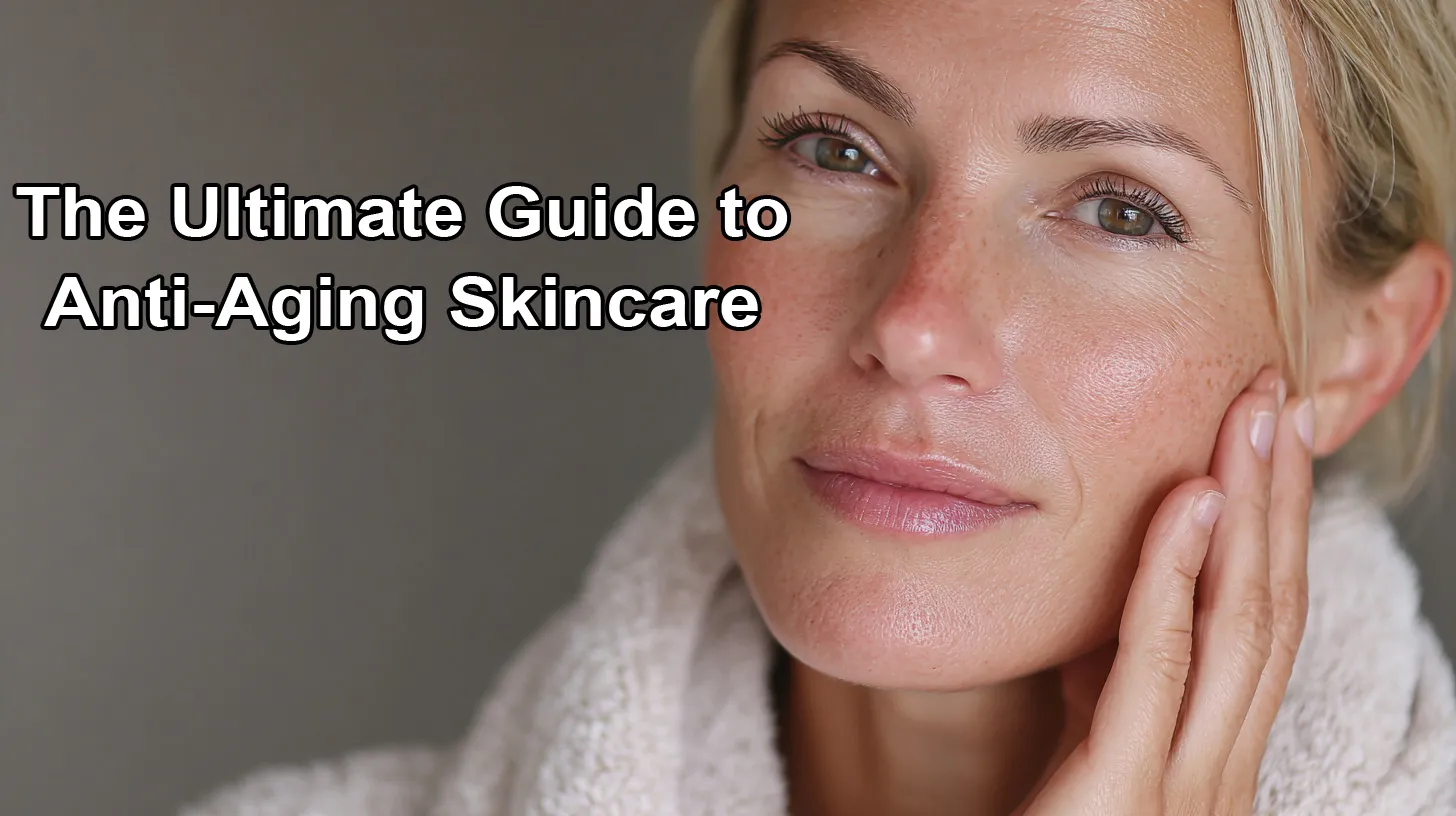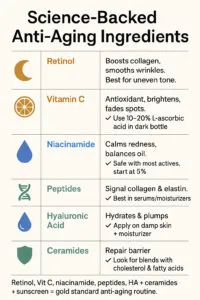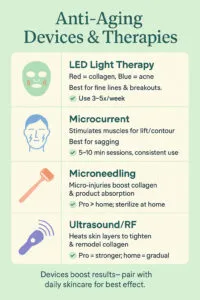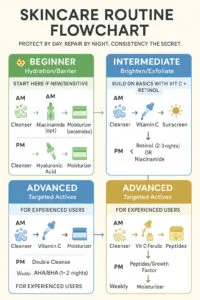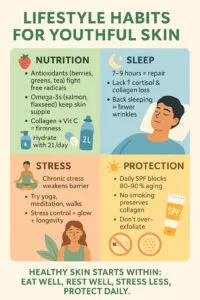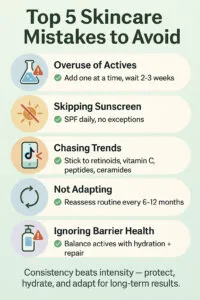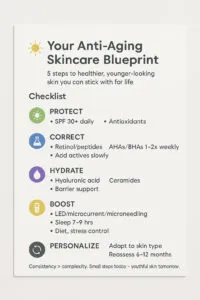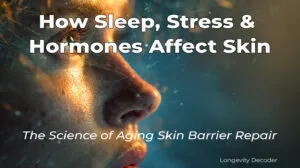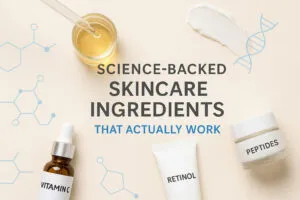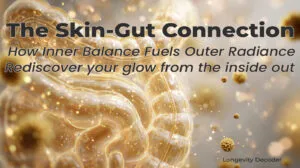I. Introduction: Why Anti-Aging Skincare Matters
The natural aging process does not stop you from achieving optimal appearance and feeling great at any stage of life. The modern world has seen an increasing number of people seeking scientifically validated skincare products that deliver both cosmetic benefits and sustained skin health and extended lifespan.
The field of skincare has evolved into a practice that combines dermatological breakthroughs with nutritional science and bioactive compounds to deliver more than just beauty results, while also protecting skin cells and preventing damage. People who notice their first signs of aging in their 30s and those who want to reverse aging in their 50s and beyond can achieve better results through a well-planned, sustainable skincare approach.
In this comprehensive guide, we’ll walk you through:
- Both the mechanisms and reasons behind skin aging as well as the proven ingredients for skincare success.
- Provides instructions for creating optimal morning and evening skincare routines.
- Explain which devices and lifestyle choices enhance your skincare outcomes.
- Identify essential mistakes that users should prevent when following their skincare plan.
- Teach readers how to create personalized skincare plans tailored to their specific skin needs.
The goal of this program does not involve seeking flawless results. The program delivers practical knowledge along with effective methods that help you care for your skin throughout the present and future years.
II. Understanding How Skin Ages
The foundation for creating an effective anti-aging skincare routine requires knowledge about the biological and environmental changes that occur in your skin during aging. The surface-level signs of aging such as wrinkles and sagging skin represent only a small portion of the complete aging process. The following analysis examines the fundamental biological elements and environmental factors which affect aging skin.
The Biology of Aging Skin
- The skin undergoes essential cellular transformations which occur during the aging process.
- The skin loses its structure and firmness because of declining collagen and elastin production which starts during your mid-20s. The reduction in elastin and collagen production starts during your mid-20s which causes your skin to become thinner and less elastic.
- The natural process of cell renewal in younger skin becomes slower with age which leads to dead skin cell accumulation and creates a dull rough skin texture.
- Free radicals which stem from pollution and UV exposure and internal metabolic activities damage healthy skin cells while speeding up the aging process.
- The body produces fewer natural oils which maintain skin hydration and plumpness thus causing dryness and impaired skin barrier function.
Environmental vs. Genetic Aging
The aging process shows different characteristics between individuals. Experts differentiate between two main categories of aging.
- Your DNA determines the natural aging process which experts call intrinsic aging. The aging process occurs at a steady pace and continues without any possibility of stopping.
- The aging process which results from environmental factors including sun exposure and smoking and poor diet and pollution can be controlled and prevented. People can control this type of aging.
Common Signs of Aging Skin
The most apparent changes that occur to the skin include:
- Fine lines and deep wrinkles
- The skin loses its firmness while developing sagging characteristics.
- The skin develops uneven coloration and dark spots appear as hyperpigmentation.
- Dryness and rough texture
- The skin appears dull and tired to the eye.
- Enlarged pores
The positive aspect is that most aging signs can be controlled through proper ingredient selection and consistent practice.
III. Core Anti-Aging Skincare Principles
The pursuit of anti-aging skincare requires patience because it demands consistent application of scientific principles which produce results through time. The process of skincare maintenance requires a long-term dedication to skin health rather than a short-term project.
Prevention vs. Correction
- Prevention: Protecting your skin from UV damage, oxidative stress, and dehydration at an early stage will reduce your need for future corrective treatments. Your skin protection begins with sunscreen application, antioxidant use, and daily gentle skincare routines.
- Correction: When aging signs such as wrinkles, discoloration, and sagging skin appear, you can use specific treatments and ingredients that help restore your skin while promoting rejuvenation. The combination of these two methods produces the best results.
Consistency and Long-Term Strategy
The effects of skincare products accumulate through time like compound interest. Using the best ingredients sporadically will not produce enduring changes in your skin. Daily skincare routines performed twice a day will make the most noticeable and sustainable improvements in your skin.
- The use of retinol and peptides as active ingredients requires 8–12 weeks of regular application to produce noticeable results.
- The practice of frequently switching between skincare products should be avoided because it prevents you from determining their actual effectiveness.
Importance of a Personalized Routine
Every person has distinct skin characteristics that make their skin unique. The skincare products that benefit one person might not deliver the same results for another person. Consider the following factors when creating your skincare plan.
- Skin types include oily skin, dry skin, combination skin, and sensitive skin.
- Skin concerns: The treatment plan should address specific skin issues which include fine lines and pigmentation and acne and dryness and loss of skin firmness.
- Lifestyle choices including sun exposure and diet and stress levels and sleep quality affect your skin health.
- Age and Stage: The way you approach skincare changes as you age because preventive measures during your 20s differ from corrective treatments in your 50s.
A well-designed skincare plan adjusts its approach to match the evolving requirements of your skin throughout different life stages.
The fundamental principle of anti-aging skincare involves protecting your existing skin while fixing noticeable issues and maintaining a long-term commitment.
Key takeaway: Anti-aging skincare succeeds when it’s protective, corrective, consistent, and personal—not when it’s complicated.
Prevention vs. Correction — In Practice
-
Prevention Example (30s and younger):
Sarah, 29, has no major wrinkles but works outdoors several days a week. Her routine focuses on:-
Daily sunscreen (broad spectrum SPF 30+)
-
Vitamin C serum in the morning for antioxidant protection
-
Gentle cleanser and hydrating moisturizer at night
-
Occasional exfoliation to keep skin smooth
👉 Result: By focusing on protection and hydration now, Sarah reduces the need for corrective treatments later.
-
-
Correction Example (40s–50s+):
James, 47, notices crow’s feet and uneven skin tone. His updated routine includes:-
Retinol or prescription retinoid at night to stimulate cell turnover
-
Peptides and hyaluronic acid to restore firmness and hydration
-
Niacinamide to improve texture and calm redness
-
Strict sunscreen use to prevent further damage
👉 Result: Over time, James softens fine lines, improves skin texture, and prevents new signs of aging.
-
Consistency and Long-Term Strategy — Realistic Routine
-
Morning Routine (5 minutes):
-
Cleanser
-
Vitamin C or niacinamide serum
-
Lightweight moisturizer
-
Sunscreen (non-negotiable)
-
-
Evening Routine (10 minutes):
-
Cleanser (gentle, maybe double cleanse if wearing makeup)
-
Active treatment (retinol, peptides, or AHA/BHA depending on skin goals)
-
Hydrating serum or cream with hyaluronic acid or ceramides
-
Moisturizer for barrier repair
-
Consistency matters more than chasing dozens of products. Even a 3–4 step routine done daily beats a 10-step routine you only do occasionally.
Personalization in Action
-
Oily skin? Choose lightweight gel moisturizers and avoid heavy oils.
-
Dry skin? Use cream cleansers, thicker moisturizers, and ceramides.
-
Sensitive skin? Start slowly with actives, introduce one product at a time, and patch test.
-
Busy lifestyle? Simplify to cleanse → treat → moisturize → protect.
Your routine should fit your life, not the other way around.
IV. Science-Backed Ingredients That Work
The selection of ingredients for anti-aging skincare products determines their effectiveness. Dermatologists endorse a limited number of scientifically proven ingredients which they recommend to patients. The following ingredients should be your top choices for your skincare routine:
Retinol and Retinoids function as cellular turnover agents, which also reduce wrinkles.
- What it does: The product accelerates cell renewal while building collagen and reducing wrinkles and dark spots.
- Why it works: The scientific evidence from multiple decades proves that retinoids derived from vitamin A provide effective anti-aging results.
- Best for: The product benefits users who want to address wrinkles, skin tone irregularities, and skin texture problems.
- Pro Tip: Begin with a retinol product available over the counter, which contains 0.25–0.5% concentration, before you can progress to stronger prescription-strength formulas. Use the product during nighttime hours while applying sunscreen protection to your skin throughout the day.
Vitamin C – Antioxidant & Brightening
- What it does: The antioxidant properties of Vitamin C help protect skin from free radicals while simultaneously brightening the complexion and reducing hyperpigmentation.
- Why it works: The antioxidant properties of this substance help build collagen while protecting cells from damage.
- Best for: The product benefits users who want to address dullness, sun-damaged skin, and uneven skin tone.
- Pro tip: The recommended concentration of L-ascorbic acid for skin care products should be between 10–20%. The packaging should remain opaque because it protects the product from oxidation.
Niacinamide – Barrier Support & Texture Smoothing
- What it does: The skin benefits from Niacinamide, which strengthens its protective barrier while reducing redness and minimizing pores and controlling oil production.
- Why it works: The compound known as vitamin B3 contains anti-inflammatory and barrier-repair properties, which make it effective for skin care.
- Best for: The product benefits users with sensitive skin or acne issues who want to reduce pore size and achieve improved skin texture.
- Pro tip: The product combines well with all ingredients, including vitamin C, according to modern scientific evidence, despite previous misconceptions. The recommended starting concentration for this product should be 5%.
Peptides – Collagen Stimulation
- What it does: Peptides function as collagen-stimulating agents that send signals to skin cells to produce elastin and collagen.
- Why it works: The substance functions as a signaling mechanism that triggers skin cells to generate elastin and collagen.
- Best for: The product benefits users who experience sagging skin and loss of firmness and want to reduce their fine lines.
- Pro tip: The best results occur when you use this product in combination with other active ingredients within moisturizers or serums.
Hyaluronic Acid – Hydration & Plumping
- What it does: The substance attracts water molecules to skin cells, which creates a plump appearance that resembles youthful skin.
- Why it works: The natural humectant functions as a water binder that can hold 1000 times its own weight in water.
- Best for: The product provides excellent benefits for people with dry skin and those who experience fine dehydration lines.
- Pro tip: Apply the product to your damp skin before securing it with a moisturizer.
Ceramides – Skin Barrier Repair
- What it does: Ceramides function as protective agents that restore the lipid structure between skin cells to prevent moisture loss and skin irritation.
- Why it works: The aging process causes ceramide levels to decrease, which weakens the skin barrier and results in dryness.
- Best for: The product benefits users who have sensitive skin, along with those whose skin barrier shows signs of damage.
- Pro tip: When searching for moisturizers, choose products containing ceramides together with cholesterol and fatty acids to achieve complete barrier repair.
AHAs/BHAs – Gentle Exfoliation & Glow
- What it does: AHAs/BHAs function as gentle exfoliants, which help create a radiant complexion through their ability to remove dead skin cells and unclog pores.
- Why it works: The treatment process involves three main actions: surface texture improvement, pore clearing, and skin radiance enhancement.
- Best for: The treatment benefits users who experience dullness and a rough skin texture, as well as those with acne-prone skin.
- Pro tip: Begin with one to two applications per week when using retinol products and other exfoliants.
Anti-Aging Skincare Ingredients at a Glance
| Ingredient | What It Does | Best For | Pro Tips |
|---|---|---|---|
| Retinol & Retinoids | Boosts collagen, speeds cell turnover, smooths wrinkles | Wrinkles, uneven tone, rough texture | Start low (0.25–0.5%), use only at night, always wear sunscreen |
| Vitamin C | Dullness, sun damage, pigmentation | Antioxidant protection, brightens, supports collagen | Use 10–20% L-ascorbic acid, store in opaque packaging |
| Niacinamide | Strengthens barrier, reduces redness, smooths texture | Sensitive skin, large pores, uneven texture | Gentle, safe for most skin; start at ~5% concentration |
| Peptides | Signals skin to produce collagen & elastin | Loss of firmness, sagging, fine lines | Works best in serums/moisturizers with other actives |
| Hyaluronic Acid | Deep hydration, plumps fine lines | Dryness, dehydration lines | Apply to damp skin, seal with moisturizer |
| Ceramides | Replenish barrier lipids, prevent water loss | Dry, sensitive, compromised barrier | Look for ceramides + cholesterol + fatty acids together |
| AHAs/BHAs | Exfoliate dead cells, unclog pores, smooth texture | Dullness, roughness, acne-prone skin | Start 1–2x/week, don’t combine too often with retinol |
✅ Key takeaway: If your routine includes retinol, vitamin C, niacinamide, peptides, sunscreen, and hydration (hyaluronic acid + ceramides), you’ve covered the gold standard of anti-aging skincare.
Anti-Aging Skincare Ingredient Hierarchy
Beginner-Friendly (Safe for Most Skin Types)
-
Hyaluronic Acid → hydrates & plumps
-
Ceramides → strengthen skin barrier
-
Niacinamide → balances, calms, smooths
Best starting point if you’re new to skincare or have sensitive skin.
Intermediate (Effective, Requires Some Consistency)
-
Vitamin C → antioxidant & brightening
-
Peptides → stimulate collagen production
-
Gentle AHAs (like lactic acid) → mild exfoliation for glow
For those comfortable with a basic routine, ready to add targeted benefits.
Advanced (Potent, Needs Careful Use)
-
Retinol & Retinoids → gold standard for anti-aging, but can be irritating
-
Stronger AHAs (like glycolic acid) → deeper exfoliation
-
BHA (salicylic acid) → pore cleansing, great for acne-prone or oily skin
Introduce slowly, usually at night, and never forget sunscreen during the day.
Rule of thumb:
-
Start with hydration & barrier support (hyaluronic acid, ceramides, niacinamide)
-
Add antioxidants & peptides once your skin is stable
-
Graduate to retinoids and acids as tolerated, with patience and consistency
V. Devices & Therapies That Support Youthful Skin
Your skin requires additional support after you establish your skincare routine with topical products. Modern dermatology and home-based technology have introduced safe and effective treatments that extend beyond traditional skincare products. These devices help stimulate collagen and tighten the skin, accelerating noticeable improvements through regular use.
LED Light Therapy
- What it is: The treatment system utilizes specific light waves to penetrate beneath the skin surface.
- Why it works: The treatment works by activating fibroblasts to create collagen while reducing inflammation in the skin. The blue light spectrum targets bacteria that cause acne.
- Best for: The treatment works best for people who want to address fine lines and loss of firmness and acne-prone skin.
- Pro Tip: The use of at-home masks and handheld devices becomes effective when used three to five times per week. The treatment produces noticeable outcomes through a process of steady progression.
Microcurrent Devices
- What it is: The device sends low-intensity electrical signals which duplicate the natural bioelectricity found in the human body.
- Why it works: The treatment activates facial muscles to enhance skin firmness and tone. The treatment provides a non-invasive alternative to traditional facelift procedures.
- Best for: The treatment works best for patients who want to address sagging skin and loss of facial definition and tired-looking complexion.
- Pro tip: The device produces optimal results when users perform short treatment sessions of 5–10 minutes either daily or multiple times per week.
Microneedling
- What it is: The device contains thin needles which produce controlled injuries in the skin surface.
- Why it works: The treatment activates skin healing mechanisms which produce fresh collagen and elastin. The treatment helps products penetrate deeper into the skin.
- Best for: The treatment works best for treating wrinkles and acne scars and improving skin texture and reducing pore size.
- Pro tip: The use of professional treatments produces better results but derma rollers used properly at home can still provide benefits. After using a derma roller you should apply products that protect your skin barrier.
Ultrasound & Radiofrequency (RF) Therapy
- What it is: The treatment system applies energy waves to heat up the deeper skin layers.
- Why it works: The treatment method promotes long-term collagen remodeling and tissue tightening effects.
- Best for: The treatment targets patients with moderate sagging skin and those who experience loss of firmness and develop jowls.
- Pro tip: The treatment requires professional clinic-based sessions for optimal results but some RF devices exist for home use. The treatment produces slow and progressive results which develop throughout several months.
✅ Key takeaway: Devices and therapies can be powerful allies in an anti-aging plan—but they work best when paired with daily skincare and healthy lifestyle habits. Think of them as accelerators, not substitutes.
Anti-Aging Devics & Therapies at a Glance
| Device / Therapy | What It Does | Best For | Pro Tips |
|---|---|---|---|
| LED Light Therapy | Red light stimulates collagen; blue light reduces acne bacteria | Fine lines, loss of firmness, acne-prone skin | Use 3–5x per week; consistency is key for visible results |
| Microcurrent Devices | Delivers low-level electrical currents to tone facial muscles | Sagging skin, loss of contour, tired appearance | Short daily/weekly sessions (5–10 min); works like a “skin gym” |
| Microneedling | Creates micro-injuries to trigger healing & collagen production | Wrinkles, scars, rough texture, enlarged pores | Professional treatments are strongest; at-home rollers require caution & sterile technique |
| Ultrasound / RF Therapy | Uses energy to heat deeper layers and remodel collagen | Moderate sagging, skin tightening, jowls | Best results from professional sessions; at-home devices require patience & consistency |
VI. Daily Routine Breakdown: AM & PM Skincare
The correct organization of your daily activities becomes essential for achieving results with advanced ingredients and devices. A well-designed morning and evening routine serves as the fundamental structure for any anti-aging treatment plan. The daytime serves as protection and prevention while nighttime brings repair and rejuvenation to your skin.
Morning Routine: Protect & Defend
Your morning objective should be to create a protective barrier against daily environmental stressors which include UV radiation and pollution and oxidative damage.
Step 1: Cleanser
- Start your day by using a gentle cleanser which removes overnight oils while preparing your skin for the next steps.
- Choose between cream or gel cleansers based on your individual skin type.
Step 2: Antioxidants
- Apply Vitamin C serum or niacinamide to your skin because they protect against free radicals and environmental stress.
Step 3: Moisturizer
- Select a lightweight hydrating lotion which should be gel for oily skin and cream for dry skin types.
- Ceramides and peptides serve as additional anti-aging agents which you should look for in your product.
Step 4: Sunscreen (Non-Negotiable)
- Apply broad-spectrum sunscreen with SPF 30 or higher in generous amounts.
- The application of sunscreen represents the most crucial step which protects your skin from premature aging.
Optional add ons: The application of eye cream for puffiness and dark circles and tinted sunscreen for extra coverage should be considered as optional additions.
Evening Routine: Repair & Renew
Your skin enters recovery mode during nighttime so you should use this period to apply restorative treatments which boost renewal processes.
Step 1: Cleanser
- The first step involves removing sunscreen products and makeup along with environmental pollutants from your skin.
- Perform a double cleansing routine that includes oil-based followed by water-based products when you use makeup and sunscreen daily.
Step 2: Actives (Targeted Treatments)
- Retinol and prescription retinoids work together with retinoids work to reduce wrinkles while promoting cell renewal.
- Use AHAs/BHAs for exfoliation and glow enhancement but alternate between them every other night.
- Apply only one potent active product at a time because multiple strong actives can cause skin irritation.
Step 3: Hydration / Barrier Support
- Hyaluronic acid serves as a hydrating product for your skin.
- The combination of ceramides and peptides and niacinamide in your moisturizer will help you achieve better results.
Step 4: Barrier Repair (if needed)
- When your skin shows signs of sensitivity or exhaustion you should replace active products with a basic nourishing cream.
Optional add-ons: The addition of overnight masks and facial oils and spot treatments should be considered based on your specific skin objectives.
Real-World Layering Advice
- The correct order for applying products should start with thin products followed by thick ones and then move from water-based to oil-based and finish with active ingredients before soothing products.
- Your skin will benefit more from three to four specific steps that you perform regularly than from a long list of products you cannot stick to.
- New active ingredients should be introduced one at a time while your skin needs the evening repair routine heals your skin. The combination of these two routines creates a daily structure which supports 2–3 weeks to adapt to each new product.
✅ Key takeaway: Your AM routine is about defense, your PM routine is about repair. Together, they form the daily foundation of long-term skin health.
Sample Anti-Aging Skincare Routines
Beginner Routine (Barrier & Hydration Focus)
Best for someone new to skincare or with sensitive skin.
AM
-
Gentle cleanser
-
Niacinamide serum (optional if skin is reactive)
-
Lightweight moisturizer with ceramides
-
Broad-spectrum sunscreen (SPF 30+)
PM
-
Gentle cleanser
-
Hyaluronic acid serum (hydration boost)
-
Ceramide-rich moisturizer
Why it works: Strengthens barrier, prevents irritation, and builds a foundation before adding stronger actives.
Intermediate Routine (Add Antioxidants & Mild Exfoliation)
Best for those comfortable with basics, looking to add brightening and mild resurfacing.
AM
-
Gentle cleanser
-
Vitamin C serum (antioxidant & glow)
-
Moisturizer with peptides or ceramides
-
Broad-spectrum sunscreen (SPF 30–50)
PM
-
Cleanser (double cleanse if wearing makeup/SPF)
-
Retinol (low-strength, 0.25–0.5%) 2–3 nights per week
-
Niacinamide serum (on alternate nights)
-
Moisturizer with hyaluronic acid + ceramides
Why it works: Adds proven actives like Vitamin C and retinol without overwhelming the skin. Alternating nights helps reduce irritation.
Advanced Routine (Targeted Anti-Aging Power)
Best for experienced users who tolerate actives well.
AM
-
Gentle cleanser
-
Vitamin C + ferulic acid serum (potent antioxidant combo)
-
Peptide serum or light moisturizer
-
Broad-spectrum sunscreen (SPF 50)
PM
-
Double cleanse (oil + water-based)
-
Retinol or prescription retinoid (nightly, as tolerated)
-
Peptides or growth factor serum (optional boost)
-
Moisturizer with ceramides + niacinamide
-
Weekly: Gentle AHA/BHA exfoliant (1–2 nights max)
Why it works: Maximizes proven anti-aging actives (retinoids, Vitamin C, peptides, AHAs), layered with barrier support to maintain tolerance.

VII. Lifestyle Habits That Enhance Skincare Results
Your lifestyle choices determine whether your results from topical skincare products and devices will be successful. Your body contains the largest organ which displays all internal changes that occur within your body. Your skincare performance depends on the elements which serve as its operational fuel.
Nutrition & Supplements for Skin Health
- Antioxidant-rich foods: The antioxidant properties of berries and leafy greens and green tea help protect your skin from oxidative stress.
- Healthy fats: Your skin stays supple because omega-3 fatty acids exist in salmon and walnuts and flaxseed.
- Collagen supplements: Research indicates that taking collagen peptides as supplements leads to better skin firmness and hydration when used for 8 to 12 weeks.
- Hydration: Drinking at least two liters of water per day will result in skin that appears more plump and healthy.
Pro tip: The combination of collagen supplements with vitamin C supplements will enhance collagen production in the body.
Sleep: Your Skin’s Repair Window
- The body produces growth hormones that activate cell repair mechanisms when you enter deep sleep.
- Insufficient sleep leads to elevated cortisol levels which damage collagen structure and intensify skin inflammation.
- Your skin needs 7 to 9 hours of sleep each night for maximum restoration.
Pro tip: Sleeping on your back helps prevent wrinkles from forming because it reduces facial pressure.
Stress Management
- The skin barrier weakens and breakouts and inflammation worsen when cortisol levels remain elevated from chronic stress.
- Daily yoga practice and meditation and walking activities help decrease stress indicators in the body.
- The reduction of stress through relaxation techniques leads to longer life expectancy together with better skin health.
Avoiding Skincare Saboteurs
- Sunlight exposure stands as the primary factor which leads to premature aging of the skin. Daily sun contact no matter how brief will accumulate so apply sunscreen daily.
- Smoking: The combination of smoking with its destructive effects on collagen and elastin leads to premature wrinkles and skin dullness.
- Over-exfoliation: The skin barrier becomes damaged when you use excessive exfoliating acids or scrubs which results in sensitivity and redness and accelerated aging.
Pro tip: The development of excellent skin requires internal factors to work with external treatments. Your skin will benefit maximally from every skincare product when you maintain a balanced diet and get enough sleep and practice stress control and stay away from common destructive habits.
VIII. Common Mistakes to Avoid
The selection of products and routines becomes ineffective when users fall into standard skincare mistakes. People unknowingly ruin their skincare outcomes through excessive or insufficient product use and following popular trends instead of scientific recommendations. The following list contains essential mistakes to identify in your skincare routine.
Overuse of Actives
- Using multiple potent skincare ingredients together at once will cause skin irritation and redness and harm your skin barrier.
- The quality of your skincare routine matters more than the quantity of products you use. Introduce new active ingredients one at a time while allowing your skin to adapt for 2 to 3 weeks.
Skipping Sunscreen
- Sunscreen stands as the most vital product for preventing aging of the skin. The best serums become ineffective at repairing UV damage because sunscreen serves as the essential protective measure.
- The combination of daily sun contact through windows and cloudy skies leads to premature aging of the skin which results in wrinkles and age spots and skin sagging.
Tip: Make SPF your essential morning skincare routine because it should never be skipped.
Chasing Trends Over Evidence
- The majority of TikTok trends along with trendy “miracle” ingredients lack scientific evidence and pose potential risks to your skin health.
- Your skincare routine will fail to produce results because you keep switching between different products.
Tip: The proven skincare ingredients retinoids and vitamin C and peptides and ceramides should be your main focus.
Not Adapting Over Time
- Skincare isn’t static. Your skin needs different care during different life stages because what worked in your twenties will not work in your forties and beyond.
- Your skin experiences behavioral changes because of hormonal shifts and environmental factors and stress levels.
Tip: Review your skincare products every 6 to 12 months because your skin needs will change over time.
Ignoring Barrier Health
- Your skin barrier becomes weak when you over-exfoliate or skip moisturizer or use harsh cleansers that strip away its natural protection.
- Your skin barrier functions as a protective shield which breaks down when damaged leading to skin irritation and dullness and accelerated aging.
Tip: The key to successful skincare requires equal attention to product selection and mistake prevention. The journey of skincare requires patience because it extends over many months.
IX. Your Personalized Anti-Aging Skincare Blueprint
The process of anti-aging skincare becomes overwhelming yet the fundamental approach to achieve lasting results involves following scientific methods through regular small actions.
Your path to obtaining healthier skin with youthful appearance exists at any stage of life through these essential steps.
1. Protect Daily
- Apply sunscreen with SPF 30 or higher protection as your daily morning skincare routine.
- The combination of antioxidants including Vitamin C and niacinamide provides additional protection to your skin.
2. Correct Strategically
- The combination of retinoids with peptides and gentle exfoliants helps treat wrinkles and improves skin texture and tone.
- Start using active ingredients at a controlled pace while maintaining a regular application schedule.
3. Hydrate & Repair
- Your skin barrier needs hyaluronic acid and ceramides to receive support.
- The use of active ingredients requires pairing with ingredients that strengthen the skin barrier.
4. Boost with Devices & Lifestyle
- LED therapy and microcurrent treatments and microneedling provide additional support for your skin health.
- Your skin requires sleep and proper nutrition and hydration and stress management to receive internal nourishment.
5. Personalize & Adapt
- Every person has a unique skin type which requires individualized care. Create a skincare plan which matches your specific requirements and desired outcomes.
- Check your skin condition and update your skincare products every six to twelve months because your skin changes and your routine needs adjustment.
✅ Bottom line: The main goal of anti-aging skincare involves creating a workable scientific skincare plan which you can maintain throughout time. Your future self will appreciate your dedication to

